VOLKSWAGEN POLO 2015 Owner´s Manual
Manufacturer: VOLKSWAGEN, Model Year: 2015, Model line: POLO, Model: VOLKSWAGEN POLO 2015Pages: 100, PDF Size: 4.14 MB
Page 81 of 100
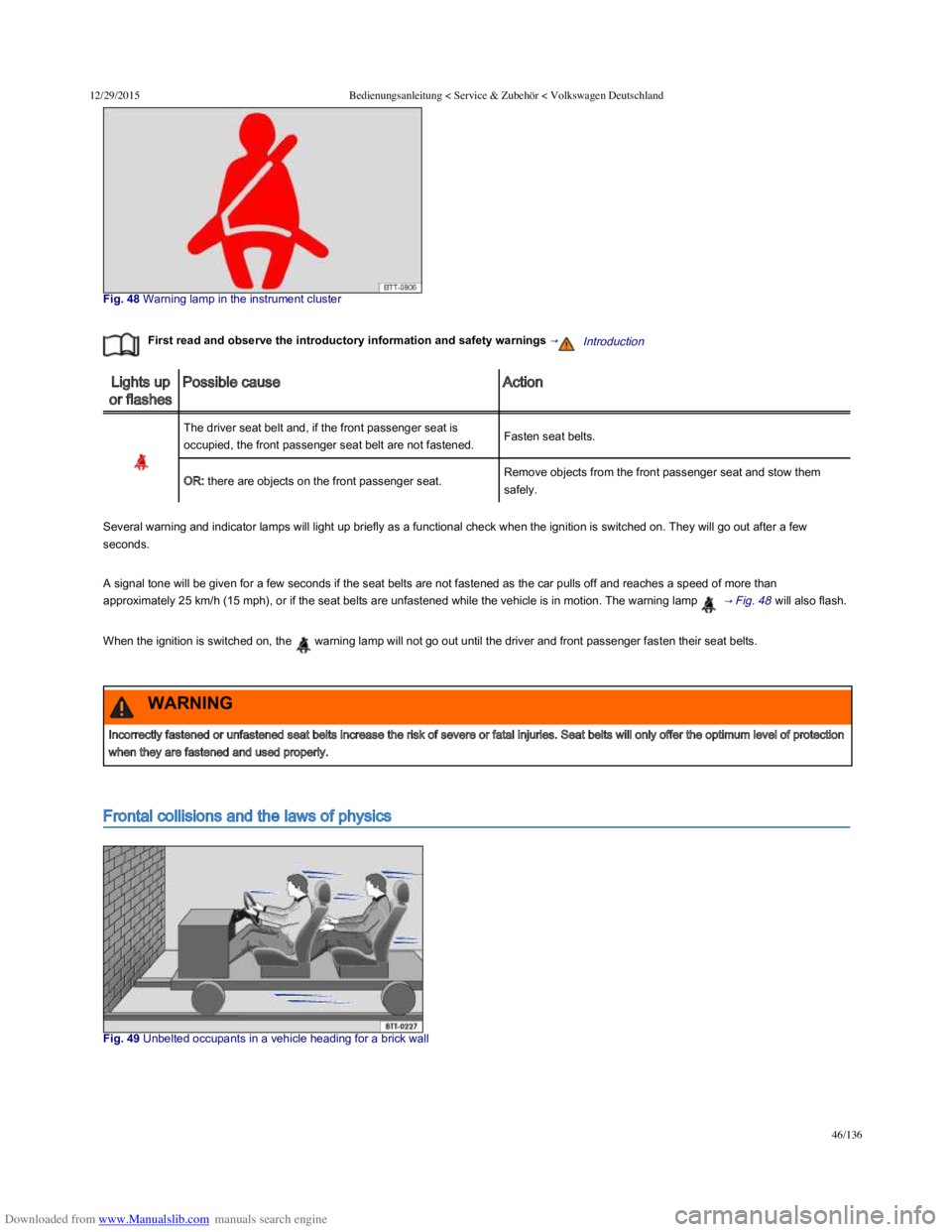
Downloaded from www.Manualslib.com manuals search engine 12/29/2015Bedienungsanleitung < Service & Zubehör < Volkswagen Deutschland
46/136
Fig. 48 Warning lamp in the instrument cluster
First read and observe the introductory information and safety warnings →Introduction
Lights up
or flashes
Possible causeAction
The driver seat belt and, if the front passenger seat is
occupied, the front passenger seat belt are not fastened.Fasten seat belts.
OR: there are objects on the front passenger seat.Remove objects from the front passenger seat and stow them
safely.
Several warning and indicator lamps will light up briefly as a functional check when the ignition is switched on. They will go out after a few
seconds.
A signal tone will be given for a few seconds if the seat belts are not fastened as the car pulls off and reaches a speed of more than
approximately 25 km/h (15 mph), or if the seat belts are unfastened while the vehicle is in motion. The warning lamp → Fig. 48 will also flash.
When the ignition is switched on, the warning lamp will not go out until the driver and front passenger fasten their seat belts.
Frontal collisions and the laws of physics
Fig. 49 Unbelted occupants in a vehicle heading for a brick wall
Incorrectly fastened or unfastened seat belts increase the risk of severe or fatal injuries. Seat belts will only offer the optimum level of protection
when they are fastened and used properly.
WARNING
Page 82 of 100
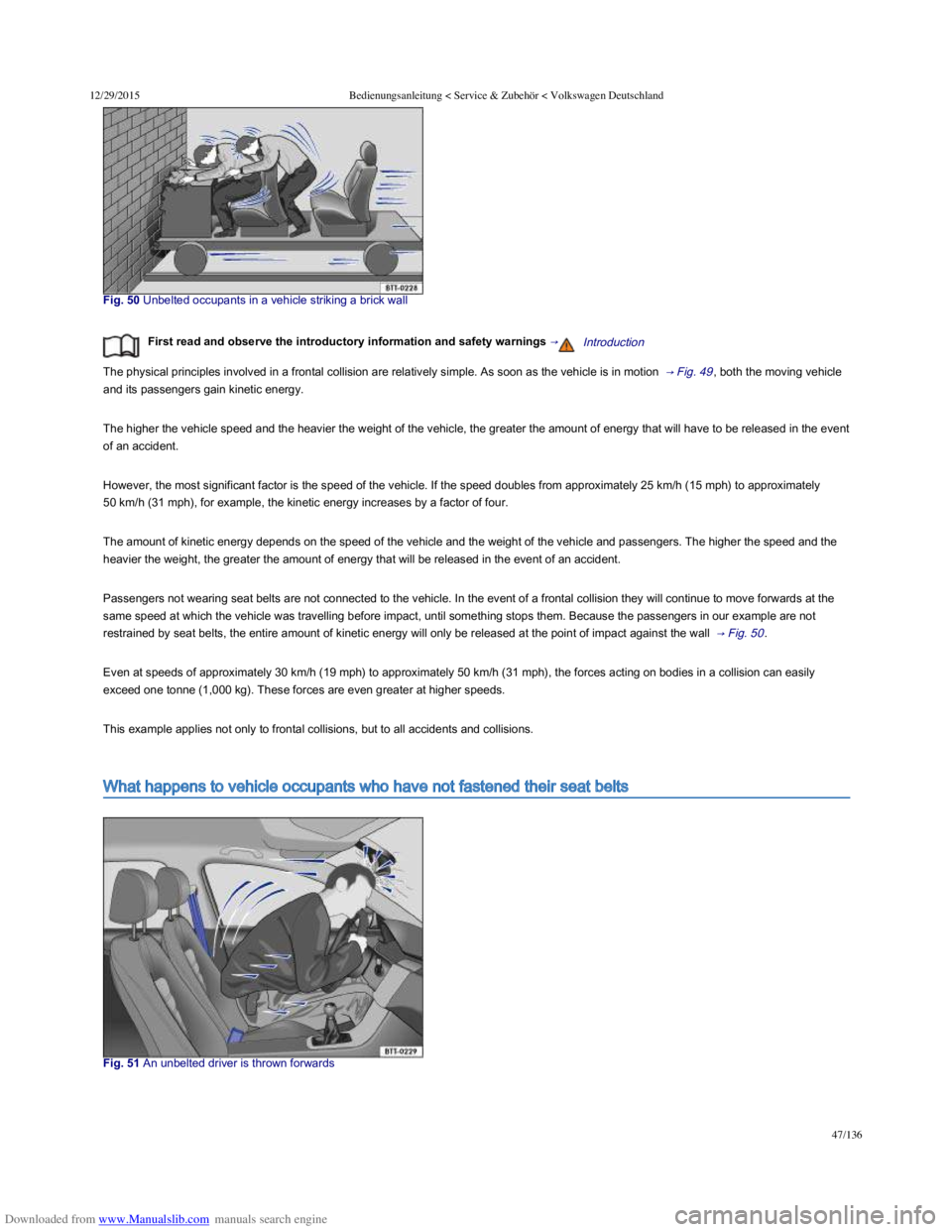
Downloaded from www.Manualslib.com manuals search engine 12/29/2015Bedienungsanleitung < Service & Zubehör < Volkswagen Deutschland
47/136
Fig. 50 Unbelted occupants in a vehicle striking a brick wall
First read and observe the introductory information and safety warnings →Introduction
The physical principles involved in a frontal collision are relatively simple. As soon as the vehicle is in motion → Fig. 49 , both the moving vehicle
and its passengers gain kinetic energy.
The higher the vehicle speed and the heavier the weight of the vehicle, the greater the amount of energy that will have to be released in the event
of an accident.
However, the most significant factor is the speed of the vehicle. If the speed doubles from approximately 25 km/h (15 mph) to approximately
50 km/h (31 mph), for example, the kinetic energy increases by a factor of four.
The amount of kinetic energy depends on the speed of the vehicle and the weight of the vehicle and passengers. The higher the speed and the
heavier the weight, the greater the amount of energy that will be released in the event of an accident.
Passengers not wearing seat belts are not connected to the vehicle. In the event of a frontal collision they will continue to move forwards at the
same speed at which the vehicle was travelling before impact, until something stops them. Because the passengers in our example are not
restrained by seat belts, the entire amount of kinetic energy will only be released at the point of impact against the wall → Fig. 50 .
Even at speeds of approximately 30 km/h (19 mph) to approximately 50 km/h (31 mph), the forces acting on bodies in a collision can easily
exceed one tonne (1,000 kg). These forces are even greater at higher speeds.
This example applies not only to frontal collisions, but to all accidents and collisions.
What happens to vehicle occupants who have not fastened their seat belts
Fig. 51 An unbelted driver is thrown forwards
Page 83 of 100
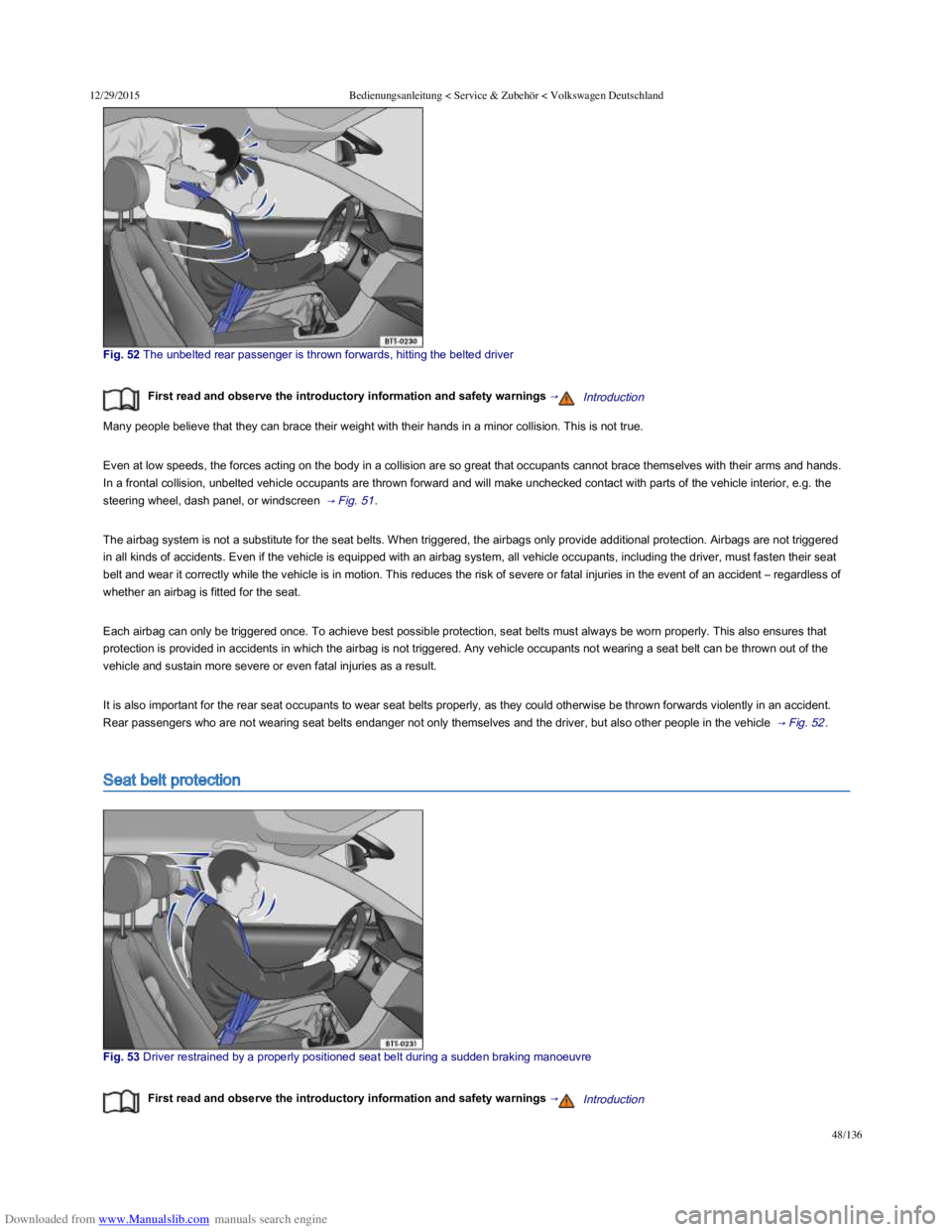
Downloaded from www.Manualslib.com manuals search engine 12/29/2015Bedienungsanleitung < Service & Zubehör < Volkswagen Deutschland
48/136
Fig. 52 The unbelted rear passenger is thrown forwards, hitting the belted driver
First read and observe the introductory information and safety warnings →Introduction
Many people believe that they can brace their weight with their hands in a minor collision. This is not true.
Even at low speeds, the forces acting on the body in a collision are so great that occupants cannot brace themselves with their arms and hands.
In a frontal collision, unbelted vehicle occupants are thrown forward and will make unchecked contact with parts of the vehicle interior, e.g. the
steering wheel, dash panel, or windscreen → Fig. 51 .
The airbag system is not a substitute for the seat belts. When triggered, the airbags only provide additional protection. Airbags are not triggered
in all kinds of accidents. Even if the vehicle is equipped with an airbag system, all vehicle occupants, including the driver, must fasten their seat
belt and wear it correctly while the vehicle is in motion. This reduces the risk of severe or fatal injuries in the event of an accident – regardless of
whether an airbag is fitted for the seat.
Each airbag can only be triggered once. To achieve best possible protection, seat belts must always be worn properly. This also ensures that
protection is provided in accidents in which the airbag is not triggered. Any vehicle occupants not wearing a seat belt can be thrown out of the
vehicle and sustain more severe or even fatal injuries as a result.
It is also important for the rear seat occupants to wear seat belts properly, as they could otherwise be thrown forwards violently in an accident.
Rear passengers who are not wearing seat belts endanger not only themselves and the driver, but also other people in the vehicle → Fig. 52 .
Seat belt protection
Fig. 53 Driver restrained by a properly positioned seat belt during a sudden braking manoeuvre
First read and observe the introductory information and safety warnings →Introduction
Page 84 of 100
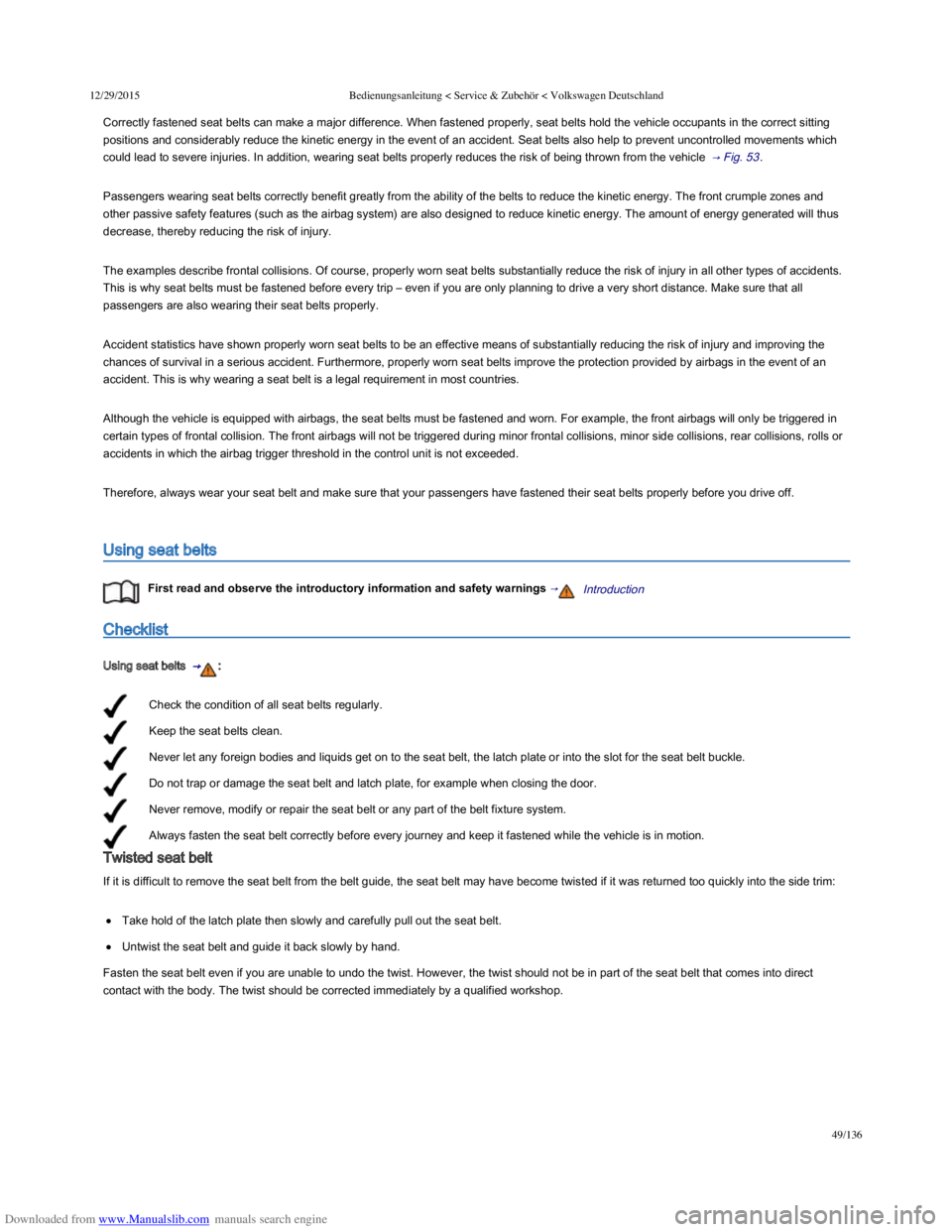
Downloaded from www.Manualslib.com manuals search engine 12/29/2015Bedienungsanleitung < Service & Zubehör < Volkswagen Deutschland
49/136
Check the condition of all seat belts regularly.
Keep the seat belts clean.
Never let any foreign bodies and liquids get on to the seat belt, the latch plate or into the slot for the seat belt buckle.
Do not trap or damage the seat belt and latch plate, for example when closing the door.
Never remove, modify or repair the seat belt or any part of the belt fixture system.
Always fasten the seat belt correctly before every journey and keep it fastened while the vehicle is in motion.
Correctly fastened seat belts can make a major difference. When fastened properly, seat belts hold the vehicle occupants in the correct sitting
positions and considerably reduce the kinetic energy in the event of an accident. Seat belts also help to prevent uncontrolled movements which
could lead to severe injuries. In addition, wearing seat belts properly reduces the risk of being thrown from the vehicle → Fig. 53 .
Passengers wearing seat belts correctly benefit greatly from the ability of the belts to reduce the kinetic energy. The front crumple zones and
other passive safety features (such as the airbag system) are also designed to reduce kinetic energy. The amount of energy generated will thus
decrease, thereby reducing the risk of injury.
The examples describe frontal collisions. Of course, properly worn seat belts substantially reduce the risk of injury in all other types of accidents.
This is why seat belts must be fastened before every trip – even if you are only planning to drive a very short distance. Make sure that all
passengers are also wearing their seat belts properly.
Accident statistics have shown properly worn seat belts to be an effective means of substantially reducing the risk of injury and improving the
chances of survival in a serious accident. Furthermore, properly worn seat belts improve the protection provided by airbags in the event of an
accident. This is why wearing a seat belt is a legal requirement in most countries.
Although the vehicle is equipped with airbags, the seat belts must be fastened and worn. For example, the front airbags will only be triggered in
certain types of frontal collision. The front airbags will not be triggered during minor frontal collisions, minor side collisions, rear collisions, rolls or
accidents in which the airbag trigger threshold in the control unit is not exceeded.
Therefore, always wear your seat belt and make sure that your passengers have fastened their seat belts properly before you drive off.
Using seat belts
First read and observe the introductory information and safety warnings →Introduction
Checklist
Using seat belts → :
Twisted seat belt
If it is difficult to remove the seat belt from the belt guide, the seat belt may have become twisted if it was returned too quickly into the side trim:
Take hold of the latch plate then slowly and carefully pull out the seat belt.
Untwist the seat belt and guide it back slowly by hand.
Fasten the seat belt even if you are unable to undo the twist. However, the twist should not be in part of the seat belt that comes into direct
contact with the body. The twist should be corrected immediately by a qualified workshop.
Page 85 of 100
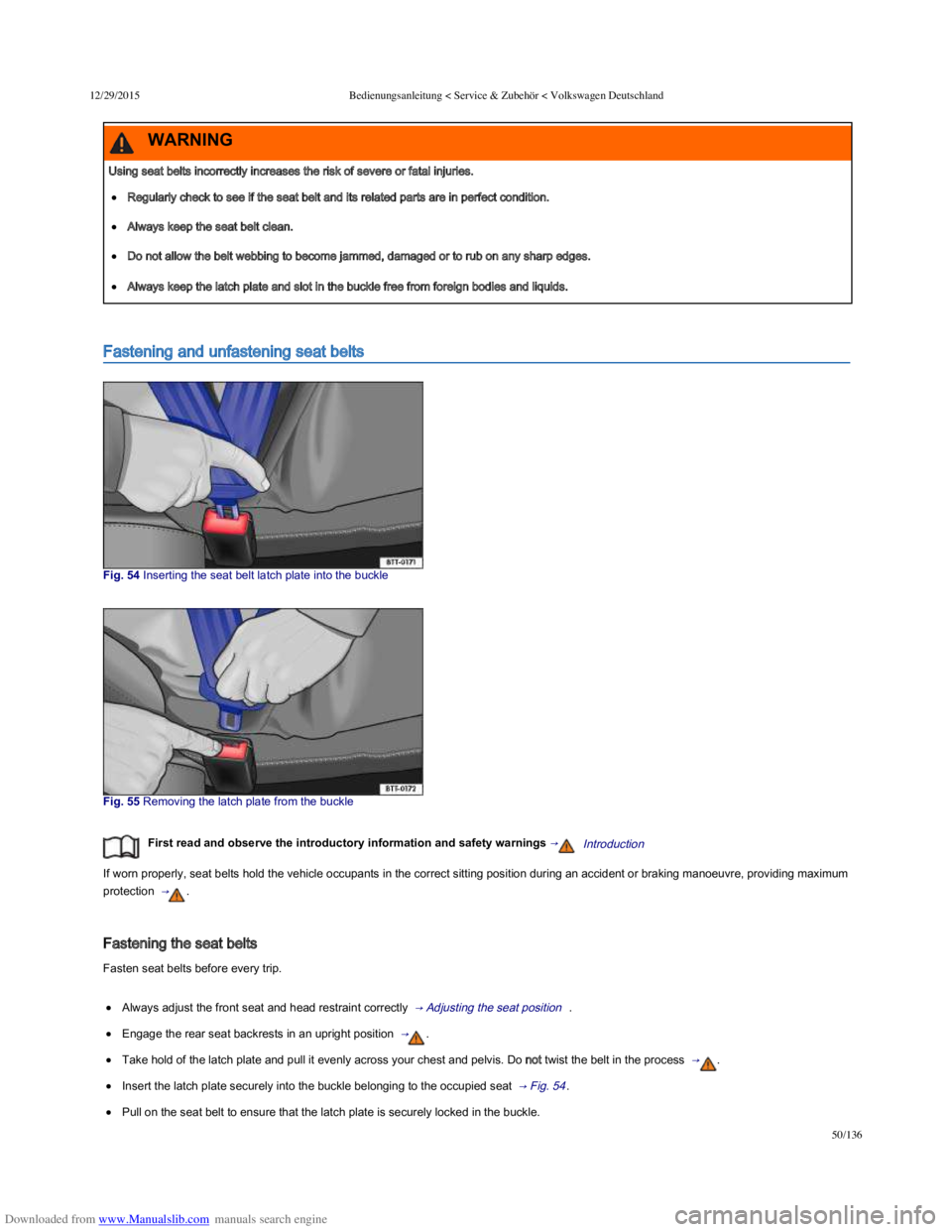
Downloaded from www.Manualslib.com manuals search engine 12/29/2015Bedienungsanleitung < Service & Zubehör < Volkswagen Deutschland
50/136
Fastening and unfastening seat belts
Fig. 54 Inserting the seat belt latch plate into the buckle
Fig. 55 Removing the latch plate from the buckle
First read and observe the introductory information and safety warnings →Introduction
If worn properly, seat belts hold the vehicle occupants in the correct sitting position during an accident or braking manoeuvre, providing maximum
protection → .
Fastening the seat belts
Fasten seat belts before every trip.
Always adjust the front seat and head restraint correctly → Adjusting the seat position .
Engage the rear seat backrests in an upright position → .
Take hold of the latch plate and pull it evenly across your chest and pelvis. Do not twist the belt in the process → .
Insert the latch plate securely into the buckle belonging to the occupied seat → Fig. 54 .
Pull on the seat belt to ensure that the latch plate is securely locked in the buckle.
Using seat belts incorrectly increases the risk of severe or fatal injuries.
Regularly check to see if the seat belt and its related parts are in perfect condition.
Always keep the seat belt clean.
Do not allow the belt webbing to become jammed, damaged or to rub on any sharp edges.
Always keep the latch plate and slot in the buckle free from foreign bodies and liquids.
WARNING
Page 86 of 100
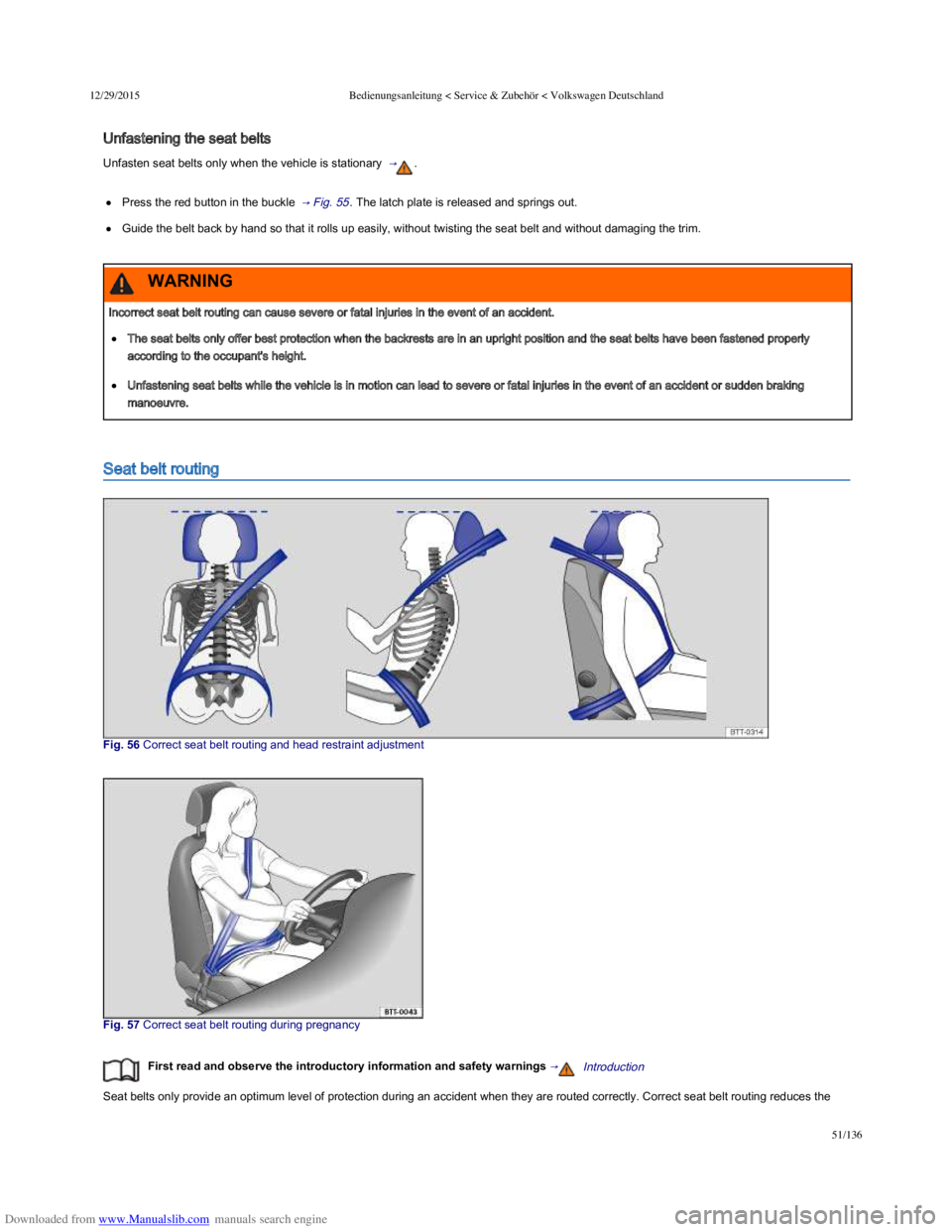
Downloaded from www.Manualslib.com manuals search engine 12/29/2015Bedienungsanleitung < Service & Zubehör < Volkswagen Deutschland
51/136
Unfastening the seat belts
Unfasten seat belts only when the vehicle is stationary → .
Press the red button in the buckle → Fig. 55 . The latch plate is released and springs out.
Guide the belt back by hand so that it rolls up easily, without twisting the seat belt and without damaging the trim.
Seat belt routing
Fig. 56 Correct seat belt routing and head restraint adjustment
Fig. 57 Correct seat belt routing during pregnancy
First read and observe the introductory information and safety warnings →Introduction
Seat belts only provide an optimum level of protection during an accident when they are routed correctly. Correct seat belt routing reduces the
Incorrect seat belt routing can cause severe or fatal injuries in the event of an accident.
The seat belts only offer best protection when the backrests are in an upright position and the seat belts have been fastened properly
according to the occupant's height.
Unfastening seat belts while the vehicle is in motion can lead to severe or fatal injuries in the event of an accident or sudden braking
manoeuvre.
WARNING
Page 87 of 100
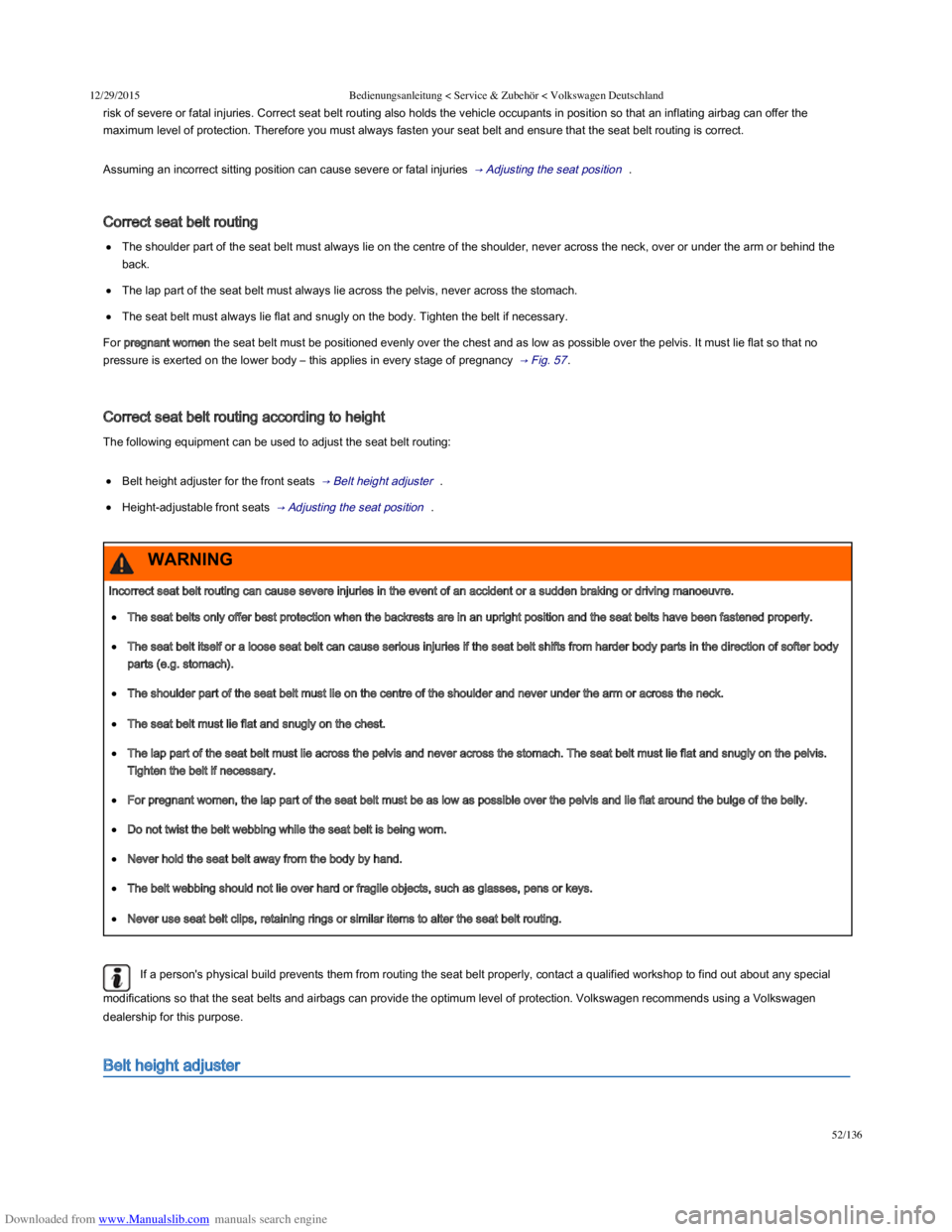
Downloaded from www.Manualslib.com manuals search engine 12/29/2015Bedienungsanleitung < Service & Zubehör < Volkswagen Deutschland
52/136
risk of severe or fatal injuries. Correct seat belt routing also holds the vehicle occupants in position so that an inflating airbag can offer the
maximum level of protection. Therefore you must always fasten your seat belt and ensure that the seat belt routing is correct.
Assuming an incorrect sitting position can cause severe or fatal injuries → Adjusting the seat position .
Correct seat belt routing
The shoulder part of the seat belt must always lie on the centre of the shoulder, never across the neck, over or under the arm or behind the
back.
The lap part of the seat belt must always lie across the pelvis, never across the stomach.
The seat belt must always lie flat and snugly on the body. Tighten the belt if necessary.
For pregnant women the seat belt must be positioned evenly over the chest and as low as possible over the pelvis. It must lie flat so that no
pressure is exerted on the lower body – this applies in every stage of pregnancy → Fig. 57 .
Correct seat belt routing according to height
The following equipment can be used to adjust the seat belt routing:
Belt height adjuster for the front seats → Belt height adjuster .
Height-adjustable front seats → Adjusting the seat position .
If a person's physical build prevents them from routing the seat belt properly, contact a qualified workshop to find out about any special
modifications so that the seat belts and airbags can provide the optimum level of protection. Volkswagen recommends using a Volkswagen
dealership for this purpose.
Belt height adjuster
Incorrect seat belt routing can cause severe injuries in the event of an accident or a sudden braking or driving manoeuvre.
The seat belts only offer best protection when the backrests are in an upright position and the seat belts have been fastened properly.
The seat belt itself or a loose seat belt can cause serious injuries if the seat belt shifts from harder body parts in the direction of softer body
parts (e.g. stomach).
The shoulder part of the seat belt must lie on the centre of the shoulder and never under the arm or across the neck.
The seat belt must lie flat and snugly on the chest.
The lap part of the seat belt must lie across the pelvis and never across the stomach. The seat belt must lie flat and snugly on the pelvis.
Tighten the belt if necessary.
For pregnant women, the lap part of the seat belt must be as low as possible over the pelvis and lie flat around the bulge of the belly.
Do not twist the belt webbing while the seat belt is being worn.
Never hold the seat belt away from the body by hand.
The belt webbing should not lie over hard or fragile objects, such as glasses, pens or keys.
Never use seat belt clips, retaining rings or similar items to alter the seat belt routing.
WARNING
Page 88 of 100
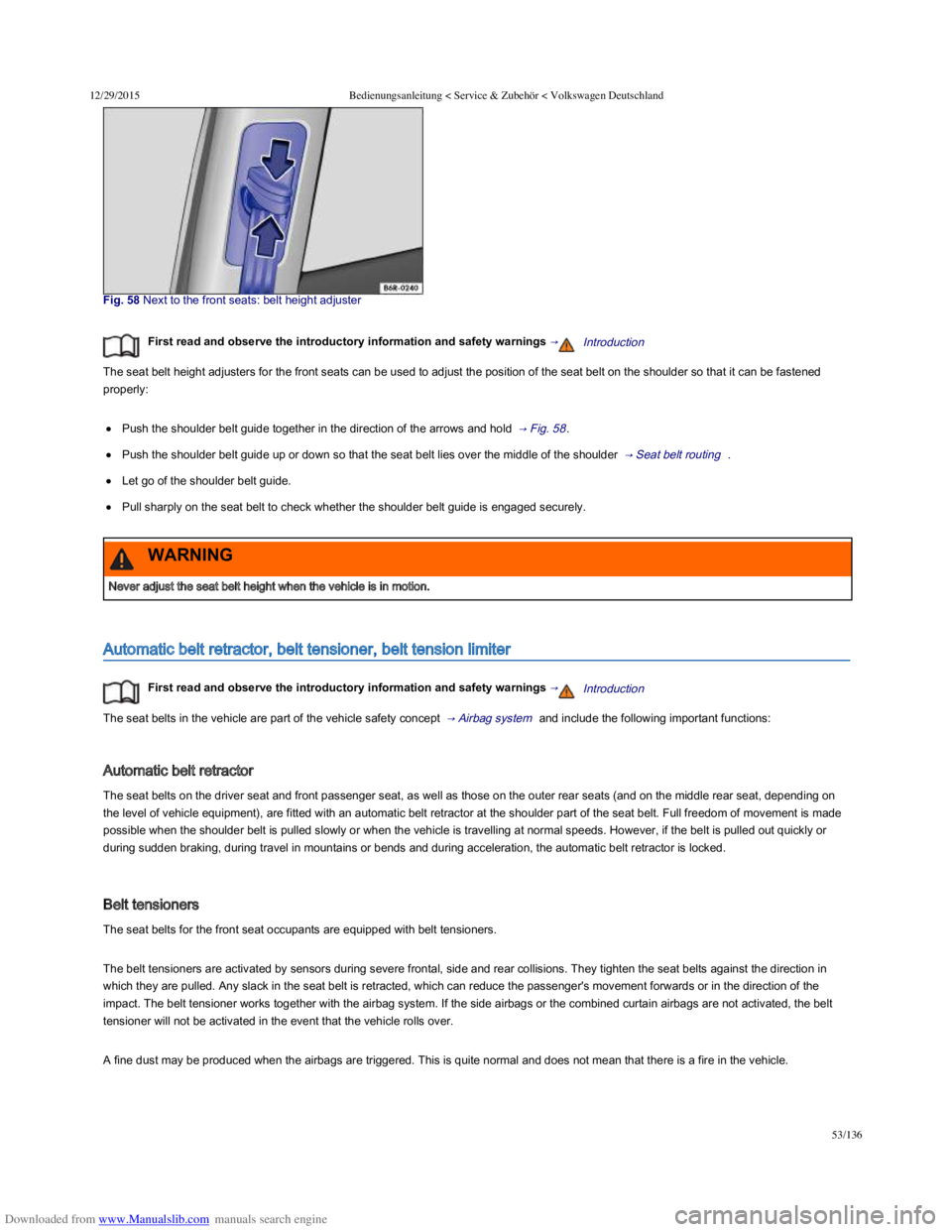
Downloaded from www.Manualslib.com manuals search engine 12/29/2015Bedienungsanleitung < Service & Zubehör < Volkswagen Deutschland
53/136
Fig. 58 Next to the front seats: belt height adjuster
First read and observe the introductory information and safety warnings →Introduction
The seat belt height adjusters for the front seats can be used to adjust the position of the seat belt on the shoulder so that it can be fastened
properly:
Push the shoulder belt guide together in the direction of the arrows and hold → Fig. 58 .
Push the shoulder belt guide up or down so that the seat belt lies over the middle of the shoulder → Seat belt routing .
Let go of the shoulder belt guide.
Pull sharply on the seat belt to check whether the shoulder belt guide is engaged securely.
Automatic belt retractor, belt tensioner, belt tension limiter
First read and observe the introductory information and safety warnings →Introduction
The seat belts in the vehicle are part of the vehicle safety concept → Airbag system and include the following important functions:
Automatic belt retractor
The seat belts on the driver seat and front passenger seat, as well as those on the outer rear seats (and on the middle rear seat, depending on
the level of vehicle equipment), are fitted with an automatic belt retractor at the shoulder part of the seat belt. Full freedom of movement is made
possible when the shoulder belt is pulled slowly or when the vehicle is travelling at normal speeds. However, if the belt is pulled out quickly or
during sudden braking, during travel in mountains or bends and during acceleration, the automatic belt retractor is locked.
Belt tensioners
The seat belts for the front seat occupants are equipped with belt tensioners.
The belt tensioners are activated by sensors during severe frontal, side and rear collisions. They tighten the seat belts against the direction in
which they are pulled. Any slack in the seat belt is retracted, which can reduce the passenger's movement forwards or in the direction of the
impact. The belt tensioner works together with the airbag system. If the side airbags or the combined curtain airbags are not activated, the belt
tensioner will not be activated in the event that the vehicle rolls over.
A fine dust may be produced when the airbags are triggered. This is quite normal and does not mean that there is a fire in the vehicle.
Never adjust the seat belt height when the vehicle is in motion.
WARNING
Page 89 of 100
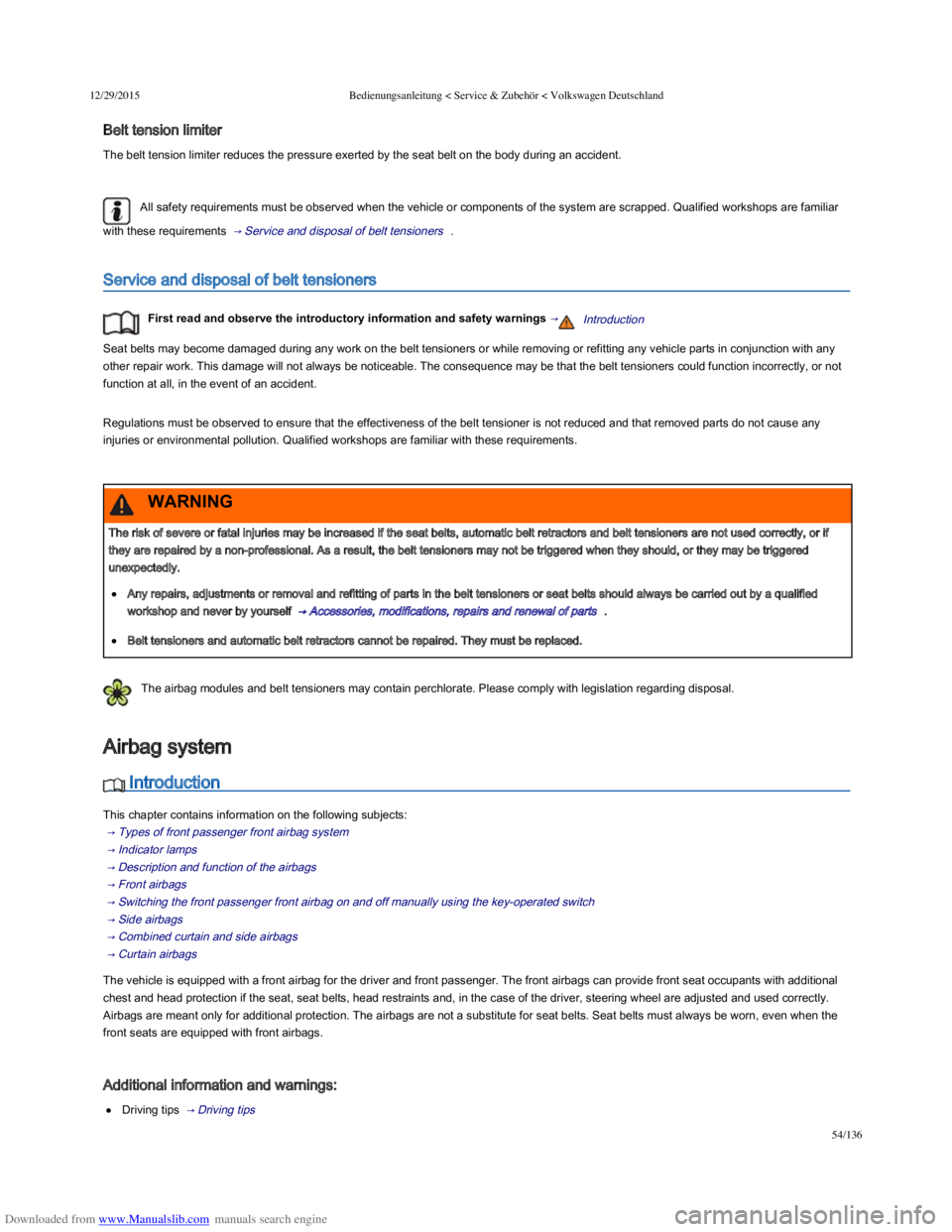
Downloaded from www.Manualslib.com manuals search engine 12/29/2015Bedienungsanleitung < Service & Zubehör < Volkswagen Deutschland
54/136
Belt tension limiter
The belt tension limiter reduces the pressure exerted by the seat belt on the body during an accident.
All safety requirements must be observed when the vehicle or components of the system are scrapped. Qualified workshops are familiar
with these requirements → Service and disposal of belt tensioners .
Service and disposal of belt tensioners
First read and observe the introductory information and safety warnings →Introduction
Seat belts may become damaged during any work on the belt tensioners or while removing or refitting any vehicle parts in conjunction with any
other repair work. This damage will not always be noticeable. The consequence may be that the belt tensioners could function incorrectly, or not
function at all, in the event of an accident.
Regulations must be observed to ensure that the effectiveness of the belt tensioner is not reduced and that removed parts do not cause any
injuries or environmental pollution. Qualified workshops are familiar with these requirements.
The airbag modules and belt tensioners may contain perchlorate. Please comply with legislation regarding disposal.
Introduction
This chapter contains information on the following subjects:
→ Types of front passenger front airbag system
→ Indicator lamps
→ Description and function of the airbags
→ Front airbags
→ Switching the front passenger front airbag on and off manually using the key-operated switch
→ Side airbags
→ Combined curtain and side airbags
→ Curtain airbags
The vehicle is equipped with a front airbag for the driver and front passenger. The front airbags can provide front seat occupants with additional
chest and head protection if the seat, seat belts, head restraints and, in the case of the driver, steering wheel are adjusted and used correctly.
Airbags are meant only for additional protection. The airbags are not a substitute for seat belts. Seat belts must always be worn, even when the
front seats are equipped with front airbags.
Additional information and warnings:
Driving tips → Driving tips
The risk of severe or fatal injuries may be increased if the seat belts, automatic belt retractors and belt tensioners are not used correctly, or if
they are repaired by a non-professional. As a result, the belt tensioners may not be triggered when they should, or they may be triggered
unexpectedly.
Any repairs, adjustments or removal and refitting of parts in the belt tensioners or seat belts should always be carried out by a qualified
workshop and never by yourself → Accessories, modifications, repairs and renewal of parts .
Belt tensioners and automatic belt retractors cannot be repaired. They must be replaced.
WARNING
Airbag system
Page 90 of 100
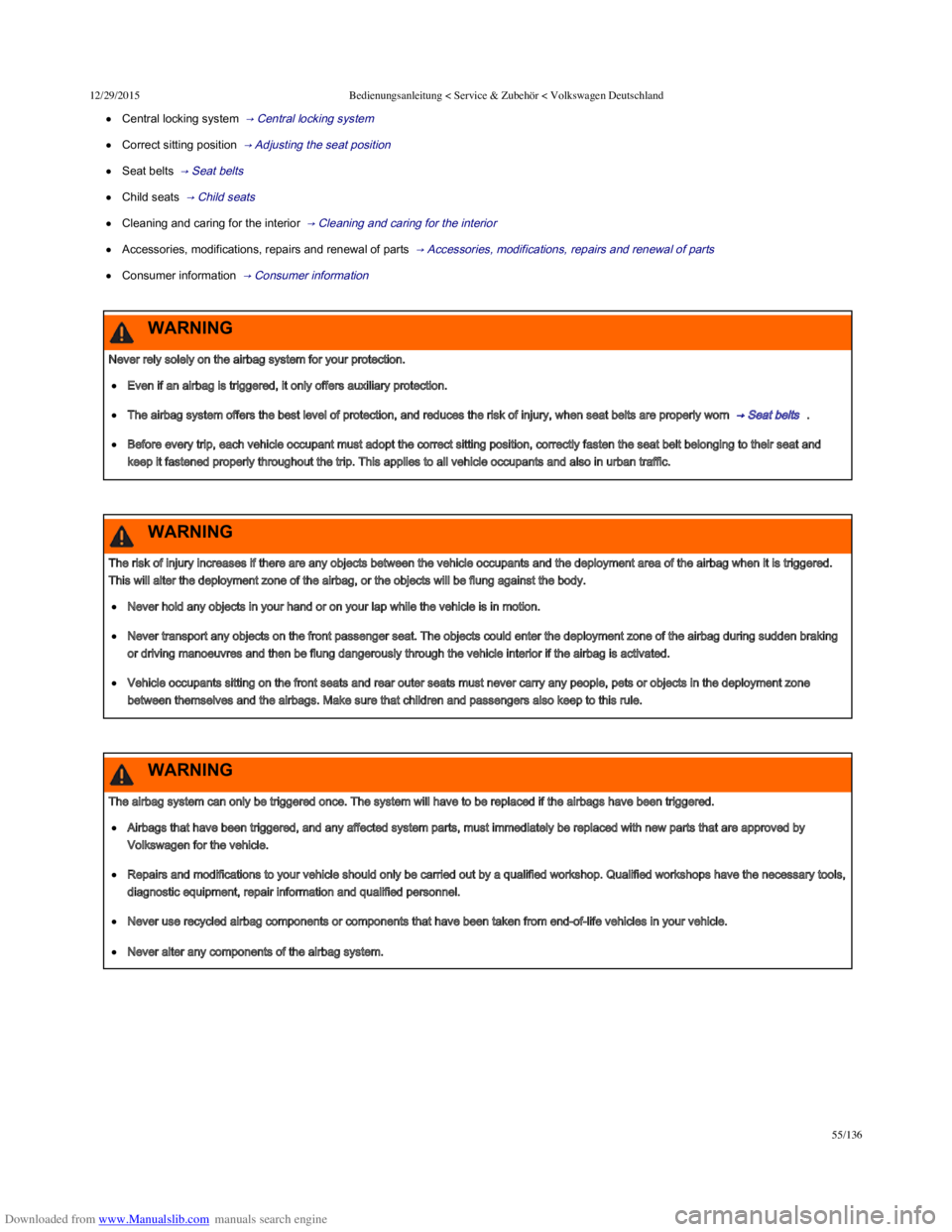
Downloaded from www.Manualslib.com manuals search engine 12/29/2015Bedienungsanleitung < Service & Zubehör < Volkswagen Deutschland
55/136
Central locking system → Central locking system
Correct sitting position → Adjusting the seat position
Seat belts → Seat belts
Child seats → Child seats
Cleaning and caring for the interior → Cleaning and caring for the interior
Accessories, modifications, repairs and renewal of parts → Accessories, modifications, repairs and renewal of parts
Consumer information → Consumer information
Never rely solely on the airbag system for your protection.
Even if an airbag is triggered, it only offers auxiliary protection.
The airbag system offers the best level of protection, and reduces the risk of injury, when seat belts are properly worn → Seat belts .
Before every trip, each vehicle occupant must adopt the correct sitting position, correctly fasten the seat belt belonging to their seat and
keep it fastened properly throughout the trip. This applies to all vehicle occupants and also in urban traffic.
WARNING
The risk of injury increases if there are any objects between the vehicle occupants and the deployment area of the airbag when it is triggered.
This will alter the deployment zone of the airbag, or the objects will be flung against the body.
Never hold any objects in your hand or on your lap while the vehicle is in motion.
Never transport any objects on the front passenger seat. The objects could enter the deployment zone of the airbag during sudden braking
or driving manoeuvres and then be flung dangerously through the vehicle interior if the airbag is activated.
Vehicle occupants sitting on the front seats and rear outer seats must never carry any people, pets or objects in the deployment zone
between themselves and the airbags. Make sure that children and passengers also keep to this rule.
WARNING
The airbag system can only be triggered once. The system will have to be replaced if the airbags have been triggered.
Airbags that have been triggered, and any affected system parts, must immediately be replaced with new parts that are approved by
Volkswagen for the vehicle.
Repairs and modifications to your vehicle should only be carried out by a qualified workshop. Qualified workshops have the necessary tools,
diagnostic equipment, repair information and qualified personnel.
Never use recycled airbag components or components that have been taken from end-of-life vehicles in your vehicle.
Never alter any components of the airbag system.
WARNING